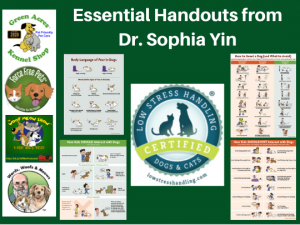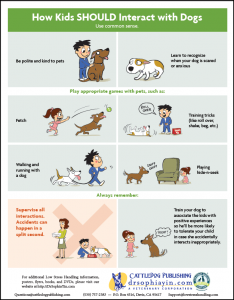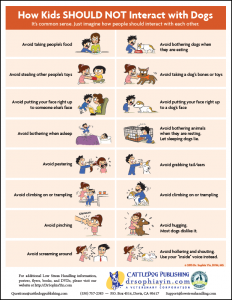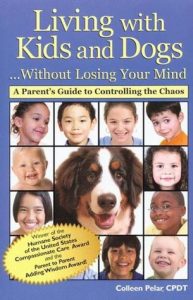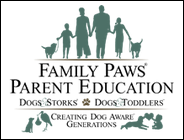< A short link for this page – https://bit.ly/YinBodyLang >
One of our most important responsibilities is to do everything we can to ensure that our puppy or adult dog feels safe. To do that successfully, we need to understand how dogs communicate. As humans, we like to vocalize; however, the dog prefers more subtle visual signals they make with various parts of their body. While a dog will bark and growl when excited or feeling threatened, they are already severely agitated by the time they do so. By learning your dog’s body language and watching them closely, you will be equipped to help them out of a frightening situation before it escalates out of control. Understanding body language is absolutely essential if you have a puppy that is in its critical socialization period (8 to 16 weeks of age) or an older puppy or adult dog that is fearful or anxious at any level.
The late Dr. Sophia Yin was an amazing veterinarian committed to helping people and dogs live in harmony. She created the following visual resources to aid adults and children. These handouts and posters can be downloaded at https://drsophiayin.com/blog/entry/free-downloads-posters-handouts-and-more/. Everyone with a dog or those that work with dogs will benefit from these 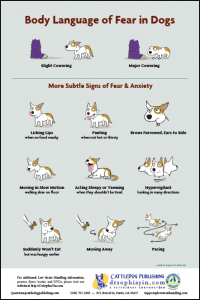 resources.
resources.
Body Language of Fear in Dogs – A puppy’s critical socialization period ends somewhere between 12 and 16 weeks of age. During this period, it is up to you to gently expose your puppy to the world so that they do not live life in a state of fear. However, to do this effectively, you need to understand a dog’s subtle body language that indicates they are uncomfortable. These signals are equally important if you have an older dog that is fearful or anxious. To successfully rehabilitate your dog, you need to be able to recognize these signals. When you see one of these signals, you need to gently get your dog out of the situation causing their fear before they start barking, growling, and lunging. This handout is an excellent introduction to these signals.
How to Greet A Dog (And What to Avoid) – Humans and dogs are two separate 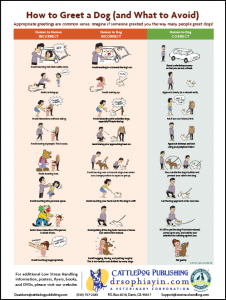 species with very different understandings of one another’s body language. While most people have the best intentions, they often greet dogs with body language and behavior that the dog will interpret as threatening. A single, unintentional incident can lead to lifelong fears in some dogs. By learning what you see in this handout and ensuring people greet your puppy or adult dog appropriately, you are helping your dog and every other dog that person may interact with in the future. Before introducing your dog to your family, friends, neighbors, or anyone else, I encourage you to provide them with a copy of this handout. I have had students who have posted it on the door to their homes.
species with very different understandings of one another’s body language. While most people have the best intentions, they often greet dogs with body language and behavior that the dog will interpret as threatening. A single, unintentional incident can lead to lifelong fears in some dogs. By learning what you see in this handout and ensuring people greet your puppy or adult dog appropriately, you are helping your dog and every other dog that person may interact with in the future. Before introducing your dog to your family, friends, neighbors, or anyone else, I encourage you to provide them with a copy of this handout. I have had students who have posted it on the door to their homes.
How Kids SHOULD Interact with Dogs – Children and dogs do NOT inherently know how to interact around one another. As a parent, it is your responsibility to teach your puppy and children how to live together happily without conflict. That requires time and active supervision. Remember, something can go wrong very quickly. This handout and its companion, How Kids SHOULD NOT Interact with Dogs, provide excellent guidance.
Socialization with Other Dogs
How your dog interacts with other dogs will also be important. That is why socializing them with other puppies of the same age, size, and playstyle between 8 and 16 weeks of age is essential. Looking for those same subtle signals outlined in the handout Body Language of Fear in Dogs will be crucial. I recommend that such interactions occur in a puppy headstart class offered by a credentialed trainer committed to reward-based training free of force, fear, and pain.
Daycare facilities with staff experienced in canine body language and behavior may also be an excellent place to help your puppy make new friends in a safe, closely supervised environment. Just remember daycare facilities are not regulated and may not provide adequate training for staff or proper supervision of the dogs in their care.
If you arrange your puppy play sessions with friends, family, or neighbors, I suggest you follow the same guidelines. Ensure that the puppies are of the same approximate age, size, and playstyle. Limit the group to two puppies and make sure each of the puppies has one of their pet parents present. Both pet parents should be familiar with the handout Body Language of Fear in Dogs. They should have all of their attention focused on supervising the puppies. No sessions should last longer than 15 to 20 minutes. If either puppy is at all hesitant about interacting with the other, stop the session and talk to your trainer.
I do not recommend taking a puppy to the dog park until they are at least one year of age. Nor do I recommend taking an adult dog to a dog park if they have not been well socialized. For a dog park to be safe, ALL dogs playing must enjoy the company of ALL other dogs. The dogs also need to be well trained and responsive to their owners. Finally, each dog needs to be accompanied by a pet parent who will be focused entirely on watching their dog; dog parks are not places for people to socialize.
You can find more resources on socialization, canine and human communication, and more below.
Recommended Resources
Articles on Don’s Blog
( http://www.words-woofs-meows.com )
Puppy Socialization and Habituation – http://blog.greenacreskennel.com/2015/06/27/dog-behavior-puppy-socialization-and-habituation/
OR http://bit.ly/SocializationPuppy
Introduction to Canine Communication – http://blog.greenacreskennel.com/2016/01/16/dog-behavior-introduction-to-canine-communication/
Understanding, Identifying and Coping with Canine Stress – http://bit.ly/Canine-Stress
________________________________________________________________________
Don Hanson is the co-owner of the Green Acres Kennel Shop ( greenacreskennel.com ) in Bangor, Maine, where he has been helping people with their pets since 1995. He is also the founder of ForceFreePets.com, an online educational resource for people with dogs and cats. Don is a Bach Foundation Registered Animal Practitioner (BFRAP), Certified Dog Behavior Consultant (CDBC), Associate Certified Cat Behavior Consultant (ACCBC), and a Certified Professional Dog Trainer (CPDT-KA). He is a member of the Pet Professional Guild (PPG). Don is committed to PPG’s Guiding Principles and the Pain-Free, Force-Free, and Fear-Free training, management, and care of all pets. He serves on the PPG Steering Committee and Advocacy Committee and is the Chair of The Shock-Free Coalition ( shockfree.org ). Don produces and co-hosts a weekly radio show and podcast, The Woof Meow Show, that airs on Z62 Retro Radio WZON (AM620) and WKIT 103.3-HD3 and is streamed at http://bit.ly/AM620-WZON every Saturday at 9 AM. Podcasts of the show are available at http://bit.ly/WfMwPodcasts/, the Apple Podcast app, and Don’s blog: www.words-woofs-meows.com. The opinions in this post are those of Don Hanson.
©05JUL21, Donald J. Hanson, All Rights Reserved
< Click for Copyright and Use Policy >
